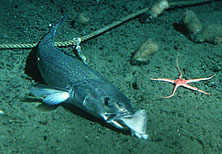
SITKA, ALASKA
But next season, they get to pull in more of the valuable species, which are prized in Asia and getting more attention in the Lower 48.
The projected total coastwide allocation is up 5 percent.NOAA Fisheries’ Dana Hanselman works on sablefish projections at Juneau’s Auke Bay Lab.
“This was primarily due to having a pretty good year on the longline survey. Catches were up about 14 percent and this resulted in higher apportionment for the eastern gulf,” he says.
The recommended limits are up by 14 percent in Southeast, 24 percent in the west Yakutat area, 5 percent in the central Gulf and 2 percent in the Bering Sea. The Western Gulf would drop 2 percent, and the Aleutians 8 percent.
The numbers are preliminary, and will be finalized at a North Pacific Fishery Management Council meeting this month.
 If they’re approved, it will be good news for longliners, who just learned next year’s overall halibut quota could drop 19 percent, with a 47 percent reduction in Southeast.
If they’re approved, it will be good news for longliners, who just learned next year’s overall halibut quota could drop 19 percent, with a 47 percent reduction in Southeast.
“It’s a little bit of a silver lining,” says Julianne Curry of the Petersburg Vessel Owners Association. “As I understand it it’s not expecting to last all that long. They’re still missing a few recruitment years. And if those don’t start showing up in any kind of significant number the sablefish quota’s expected to go down again. But it’s better than a poke in the eye.”
The recommendation would allow a 16-thousand-ton harvest in Alaska waters. That’s roughly 35 million pounds. About 25 million pounds would be taken in the Gulf of Alaska, and about 6 and a half million in Southeast. By contrast, the entire Alaska and Pacific Northwest halibut allocation for next year is 41 million pounds.
Sablefish is a growing fishery, with rising prices.
“It’s a pretty significant revenue source. Sablefish has been climbing in value steadily since IFQs were implemented and it’s a pretty important product to a lot of fishermen off the coast of Alaska,” she says.
An increase in sablefish will not boost everyone affected by the halibut reduction. Sitka’s Linda Behnken heads up the Alaska Longline Fishermen's Association.
“I would say that most people who fish sablefish also fish halibut. It isn’t necessarily true the other way. There are a lot of people who have halibut quota and fish for salmon, but don’t necessarily have any sablefish,” she says.
Allowable harvest numbers for sablefish have dropped significantly since a peak of almost 40 thousand tons in 1988. They’ve gone been up and down this decade. And after 2011’s increase, they’re projected to drop by 8 percent in 2012.
Auke Bay Lab’s Dana Hanselman says there’s a lot to be learned about the species.
“Each year’s quota really depends on the surveys we get in that year. And next year we do have two surveys that we’ll be taking a look at, plus the fishery catch rate index. And so how those come out is really the biggest predictor,” he says.
Numbers for 2011 will be finalized during the North Pacific Fishery Management Council’s meeting December 6th to December 14th in Anchorage.
Images: Center left, A sablefish rests on the soft sediments blanketing the deep canyon floor at about 2,625 feet. Lower right, Alaska landings Chart. Both courtesy of National Marine Fisheries Service.
© Copyright 1970, CoastAlaska






























